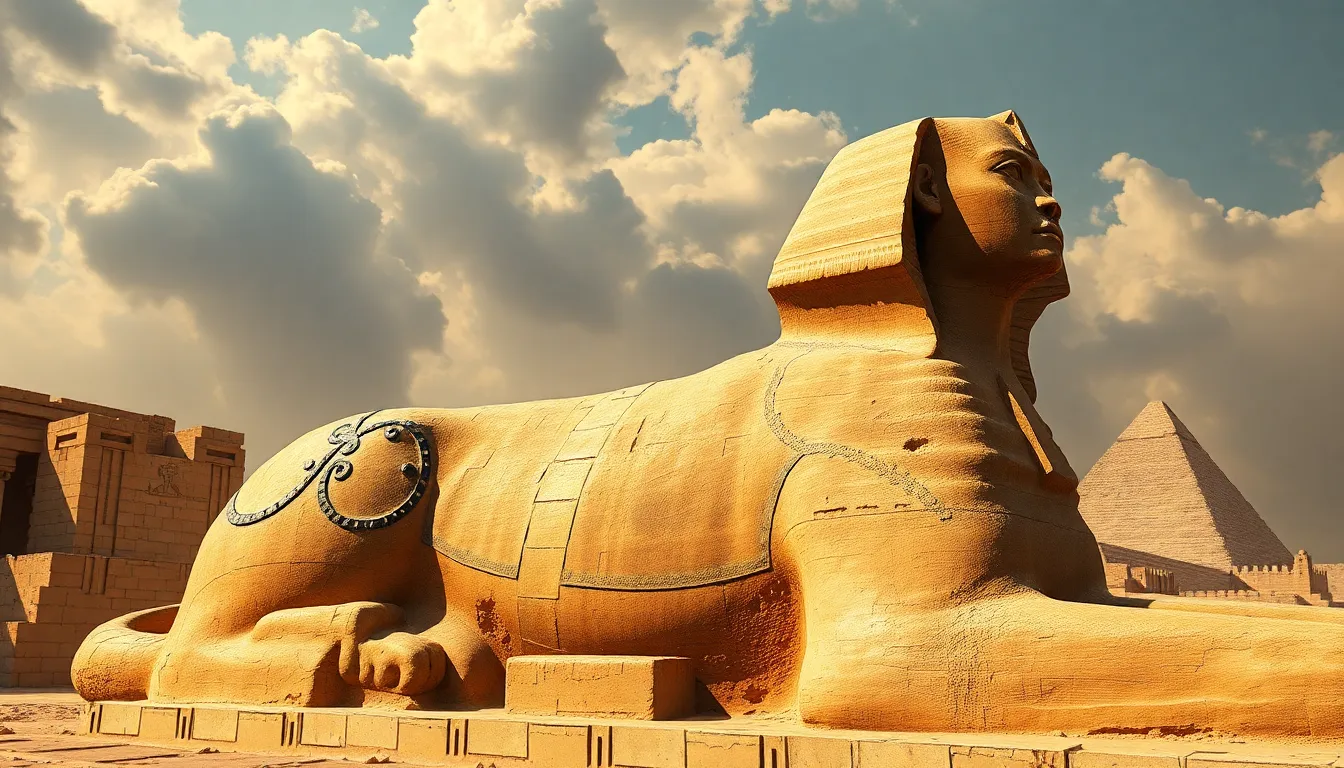The Spiritual Meaning of the Sphinx in Egyptian Culture
I. Introduction
The Sphinx stands as one of the most iconic symbols of ancient Egypt, captivating the imagination of historians, archaeologists, and tourists alike. This enigmatic creature, with a lion’s body and a human head, serves as a cultural icon that transcends time and continues to evoke curiosity about its origins and purpose.
In Egyptian mythology and spirituality, the Sphinx is not merely a monument; it embodies deep spiritual significance and represents the union of strength and wisdom. This article aims to explore the multifaceted nature of the Sphinx, delving into its historical context, symbolic meanings, connections to mythology, and its enduring legacy in both ancient and modern cultures.
II. Historical Context of the Sphinx
The Great Sphinx of Giza, located on the Giza Plateau, is believed to have been constructed during the reign of Pharaoh Khafre around 2500 BCE. Its architectural significance is profound, as it showcases the advanced engineering skills of the ancient Egyptians.
- Construction: The Sphinx is carved from a single limestone ridge, highlighting the ingenuity of ancient builders.
- Relation to the Pyramids: It is situated near the Pyramids of Giza, serving as a guardian to the tombs of the pharaohs.
- Evolution of Significance: Over time, the Sphinx has taken on various meanings, from a royal emblem to a symbol of mystery and enigma.
III. Symbolism of the Sphinx
The dual nature of the Sphinx—combining human and animal features—carries profound symbolic meaning. This duality represents important themes in ancient Egyptian spirituality.
- Duality: The human head signifies intelligence and thought, while the lion’s body represents strength and power.
- Strength and Wisdom: Together, they embody the ideal ruler, combining the qualities necessary for leadership.
- Guardian Figure: The Sphinx is often viewed as a protector, watching over sacred spaces and guiding souls in the afterlife.
IV. The Sphinx in Egyptian Mythology
The Sphinx is deeply intertwined with Egyptian mythology, with connections to significant deities and myths that enhance its spiritual importance.
- Connections to Deities: The Sphinx is often associated with the sun god Ra and the falcon-headed god Horus, symbolizing divine protection and kingship.
- Myths and Legends: Various legends surround the Sphinx, including tales of riddles that challenge the intellect of those who approach it.
- Afterlife Beliefs: As a guardian of the tombs, the Sphinx played a role in guiding the deceased through the afterlife, symbolizing the journey to eternal life.
V. The Sphinx in Spiritual Practices
The Sphinx was not only a monumental figure but also an integral part of various spiritual practices in ancient Egypt.
- Rituals and Offerings: Pilgrims would bring offerings to the Sphinx, seeking its favor and protection.
- Mediator Role: The Sphinx was seen as a bridge between the physical and spiritual worlds, facilitating communication with the divine.
- Influence on Religious Practices: Its presence influenced various religious ceremonies, emphasizing the connection between the living and the dead.
VI. Interpretations and Theories
The Sphinx has been the subject of various scholarly interpretations and theories regarding its original purpose and meaning. These interpretations reflect the complexity of ancient Egyptian culture.
- Scholarly Interpretations: Different historians and Egyptologists have proposed various meanings assigned to the Sphinx, ranging from a representation of the pharaoh to a symbol of cosmic order.
- Theories of Purpose: Some suggest it was created as a protective figure for the pyramids, while others argue it served as a solar symbol during the Pharaoh’s reign.
- Reflection of Values: The Sphinx encapsulates ancient Egyptian values such as strength, intelligence, and the divine right to rule.
VII. The Sphinx’s Legacy in Modern Culture
The influence of the Sphinx extends far beyond ancient Egypt, permeating modern art, literature, and spiritual practices.
- Influence on Art and Literature: The Sphinx has inspired countless works of art and literature, symbolizing mystery and the unknown.
- Contemporary Spirituality: In modern spiritual practices, the Sphinx is sometimes seen as a symbol of strength and protection, continuing its role as a guardian figure.
- Preservation Efforts: Archaeological efforts continue to preserve and restore the Sphinx, highlighting its historical importance and ensuring its legacy endures.
VIII. Conclusion
The Sphinx remains a powerful symbol of spiritual significance within Egyptian culture. Its dual nature as a guardian and a representation of strength and wisdom continues to intrigue and inspire. The mysteries surrounding the Sphinx are enduring, drawing scholars and visitors alike to contemplate its origins and meanings.
As we explore the depths of its historical and spiritual significance, it becomes clear that the Sphinx is not just a relic of the past but a living symbol that continues to impact our understanding of ancient Egyptian culture and spirituality.




